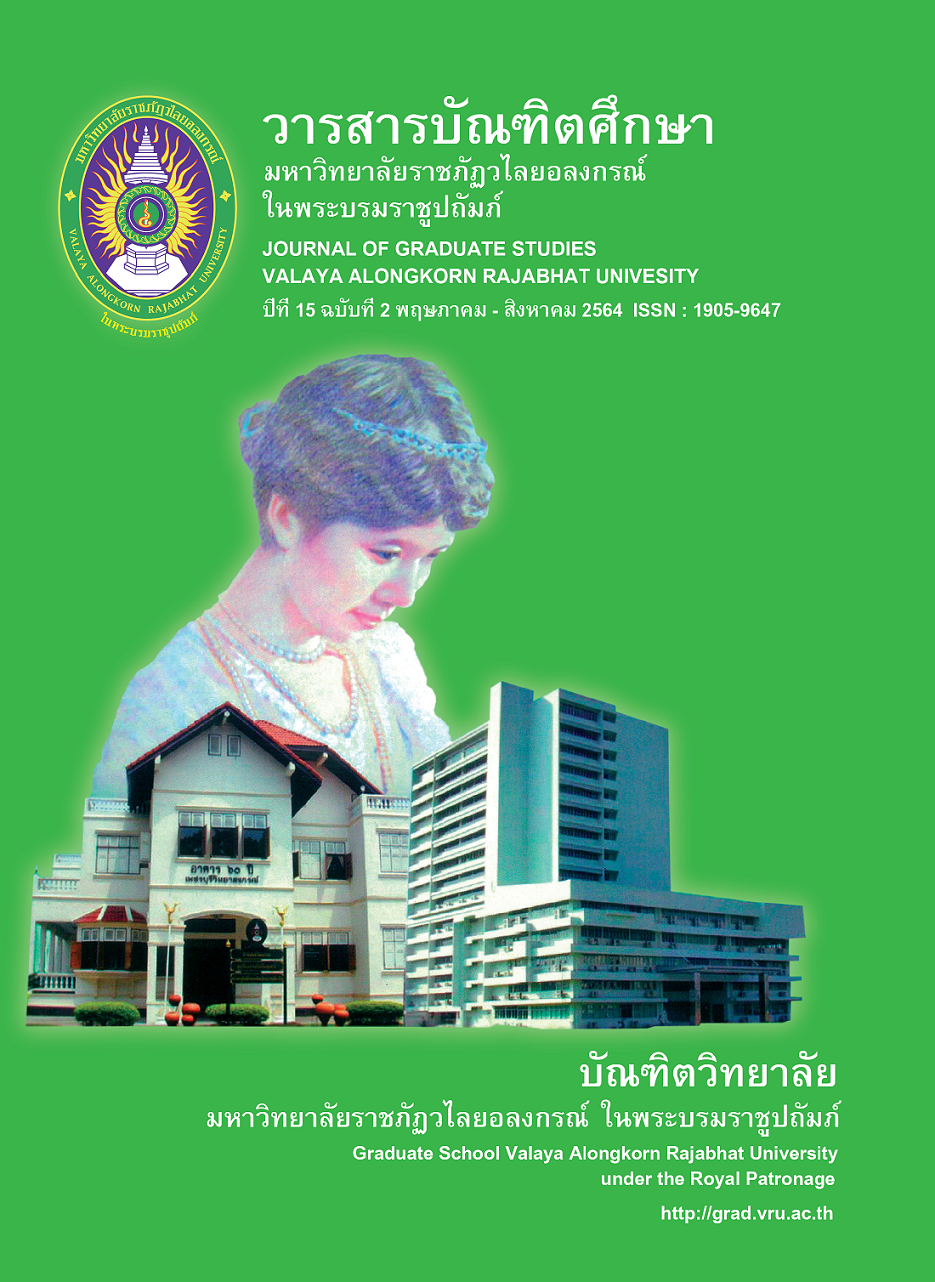การวิจัยปฏิบัติการในชั้นเรียน เพื่อส่งเสริมความสามารถในการพิสูจน์ทางเรขาคณิต ของนักเรียนชั้นมัธยมศึกษาปีที่ 2 โดยใช้ 5 แนวปฏิบัติการสอน
Main Article Content
บทคัดย่อ
การวิจัยปฏิบัติการในชั้นเรียนนี้มีวัตถุประสงค์ เพื่อส่งเสริมความสามารถในการพิสูจน์ทางเรขาคณิตผ่านการออกแบบ และจัดกิจกรรมการเรียนรู้โดยใช้ 5 แนวปฏิบัติการสอน กลุ่มเป้าหมายโดยเลือกแบบเจาะจง เป็นนักเรียนชั้นมัธยมศึกษาปีที่ 2/1 โรงเรียนสาธิตมหาวิทยาลัยเชียงใหม่ จำนวน 42 คน เครื่องมือในการวิจัย ประกอบด้วย แผนการจัดการเรียนรู้จำนวน 9 แผน บันทึกหลังการจัดการเรียนรู้ ใบงานตรวจสอบความเข้าใจ และแบบวัดความสามารถในการพิสูจน์ทางเรขาคณิตแบบอัตนัย จำนวน 9 ข้อ มีค่าอำนาจจำแนกอยู่ในช่วง 0.23 – 0.86 ค่าความยากง่ายอยู่ในช่วง 0.21 – 0.54 และค่าความเชื่อมั่น เท่ากับ 0.93 ดำเนินการวิจัยโดยใช้กระบวนการวิจัยปฏิบัติการในชั้นเรียน 4 ขั้นตอน ประกอบด้วย ขั้นวางแผน ขั้นปฏิบัติตามแผนขั้นสังเกตผลการปฏิบัติ และขั้นสะท้อนผลการปฏิบัติ จำนวน 3 วงจรต่อเนื่องกัน ผ่านการใช้ 5 แนวปฏิบัติการสอน
ผลการวิจัยพบว่า นักเรียนส่วนใหญ่มากกว่าร้อยละ 64.29 มีความสามารถในการพิสูจน์ทางเรขาคณิตในระดับดีขึ้นไป โดยนักเรียนสามารถแสดงการพิสูจน์ทางเรขาคณิต โดยอ้างอิง นิยาม สัจพจน์ และทฤษฎีบททางเรขาคณิตได้ถูกต้องเป็นส่วนใหญ่และทั้งหมด
Article Details

อนุญาตภายใต้เงื่อนไข Creative Commons Attribution-NonCommercial-NoDerivatives 4.0 International License.
บทความทุกเรื่องได้รับการตรวจความถูกต้องทางวิชาการโดยผู้ทรงคุณวุฒิ ทรรศนะและข้อคิดเห็นในบทความ Journal of Global of Perspectives in Humanities and Social Sciences (J-GPHSS) มิใช่เป็นทรรศนะและความคิดของผู้จัดทำจึงมิใช่ความรับผิดชอบของบัณฑิตวิทยาลัย มหาวิทยาลัยราชภัฏวไลยอลงกรณ์ ในพระบรมราชูปถัมภ์ กองบรรณาธิการไม่สงวนสิทธิ์การคัดลอก แต่ให้อ้างอิงแหล่งที่มา
เอกสารอ้างอิง
Brikshavana, T. (2017). kānsưksā khwāmsāmāt læ panhā nai kān phisūt thāng khanittasāt khō̜ng naksưksā laksūt sưksā sāttra bandit sākhā wichā khanittasāt mahāwitthayālai sūan Dusit [A Study of Ability and the Problems in Mathematical Proof of Educational Bachelor Degree Students, Mathematical Program, Suan Dusit University]. Journal of Multidisciplinary in Social Sciences, 13(2), 167-184.
Chaiyawong, T., & Kamol, N. (2018). kān songsœ̄m khwāmsāmāt nai kān kǣ panhā thāng khanittasāt khō̜ng nakrīan chan matthayommasưksā pī thī sō̜ng dōi chai hā nǣo patibatkān sō̜n [Promoting Mathematical Problem Solving Abilities of Grade 8 Students Using the Five Practices]. Proceeding of the 23rd Annual Meeting in Mathematics: AMM 2018 “Mathematical Science for Thailand 4.0” 3 – 5 May 2018.Mandarin Hotel Bangkok: 337–343.
Engle, R. A., & Conant, F. R. (2002). Guiding principles for fostering productive disciplinary engagement: Explaining an emergent argument in a community of learners classroom. Cognition and Instruction, 20(4), 399-483.
Goldberger, A. (2002). What are mathematical proofs and why they are important? Math 216 class, University of Connecticut.
Gutierrez, A., Pegg, J., & Lawrie, C. (2004). Characterization of Students' Reasoning and Proof Abilities in 3-Dimensional Geometry. International Group for the Psychology of Mathematics Education.
Hanna, G. (2000). Proof, explanation, and exploration: An overview. Educational studies in mathematics, 44(1-2), 5-23.
Henningsen, M., & Stein, M. K. (1997). Mathematical tasks and student cognition: Classroom-based factors that support and inhibit high-level mathematical thinking and reasoning. Journal for research in mathematics education,
-549.
Kemmis, S. and McTaggart, R. (1990). The Action Research Planner. Geelong: Deakin University Press.
Makanong, A. (2015). khrū khanittasāt samrap matthayommasưksā [Mathematics Teacher for Secondary School]. 2nd ed. Bangkok: Chulalongkorn University.
Martin, T. S., McCrone, S. M. S., Bower, M. L. W., & Dindyal, J. (2005). The interplay of teacher and student actions in the teaching and learning of geometric proof. Educational Studies in Mathematics, 60(1), 95-124.
Moothummachai, N., & Kamol, N. (2017). rūpbǣp kānchai ngān thāng khanittasāt thī songsœ̄m khwāmsāmāt nai kānhai hētphon thāng khanittasāt rư̄ang khwāmsamphan læ fangchan khō̜ng nakrīan chan matthayommasưksā pī thī sī [Using Mathematical Tasks Forms that Promoting Mathematical Reasoning Abilities in The Relationship and Function of Grade 10 Students].Proceeding of the 22nd Annual Meeting in Mathematics: AMM 2017 “Mathematics Research and National Research Strategy” 2 – 4 June 2017. Lotus Pang Suan Kaew Hotel Chiang Mai.
Richland, L. E., Begolli, K. N., Simms, N., Frausel, R. R., & Lyons, E. A. (2017). Supporting mathematical discussions: The roles of comparison and cognitive load. Educational Psychology Review, 29(1), 41-53.
Smith, M. S., & Stein, M. K. (2011). Five practices for orchestrating productive mathematics discussions. Reston, VA: National Council of Teachers of Mathematics.
Smith, M. S., Hughes, E. K., Engle, R. A., & Stein, M. K. (2009). Orchestrating discussions. Mathematics Teaching in the Middle School, 14(9): 548-556.
The Institute for the Promotion of Teaching Science and Technology. (2012). thaksa / krabūankān thāng khanittasāt [Skills/Mathematical Process]. 3rd ed. Bangkok: Kurusapa Printing Ladphrao.
The Institute for the Promotion of Teaching Science and Technology. (2019). khūmư̄ kānchai laksūt klum sāra kānrīanrū khanittasāt [Manual for curriculum in mathematics]. Retrieved from https://www.scimath.org/ebook-mathematics/item/8380-2560-2551-8380
Weikle, D. A., & Murray, M. (2014). Improving CS class discussions using the 5 practices. Journal of Computing Sciences in Colleges, 29(3), 65-71.
Wongwanich, S. (2016). kānwičhai patibatkān nai chan rīan [Classroom Action Research]. 18th ed. Bangkok: Chulalongkorn University.


